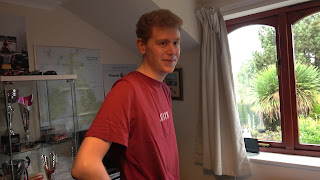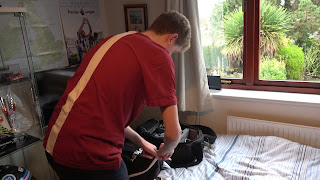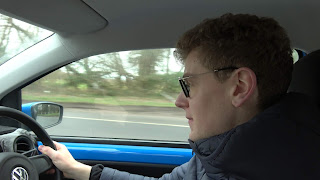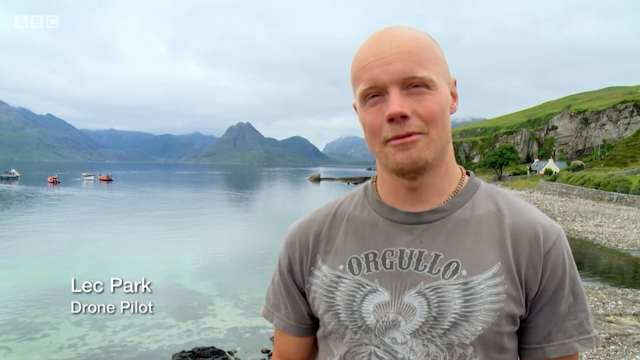It was already apparent that my shoot days would be very different to normal directors, as I am in the film myself. I learnt a lot on Monday's shoot, which allowed me to relax into my role as a contributor and go about my business of trying to complete my racing license. As can be seen in prior posts, I spent a lot of time creating an in-depth shot list with all the key shots I wanted, along with detailed camera plans of exactly where every camera would be placed along with the shots needed. I have devised a schedule with George showing how we wanted the day to pan out. This allowed us time to understand the track as a team once again, while also ensuring we captured a raw and honest view of events.



Before starting the test, I wanted to film the build-up to this big moment. As planned in the script, George asks me a few questions about how I am feeling, while I am packing up before the race. This sequence went as planned and we got a nice and honest reflection of myself before I went into one of the biggest days of this journey. I was happy with my "performance" and I have gone back and reviewed this footage since, to understand what could be improved. While keeping this documentary natural, we also wanted to ensure it was as professional as possible, meaning plans should be in place for every scene. Looking back at this scene, I think the framing and natural lighting was what we needed. However, the audio should have been much better, we should have used a clip mic instead of relying on the shotgun mic on the camera. This was an oversight by myself and Cailan and we now know that we want the clean audio from a clip mic, along with audio from a shotgun mic which can capture atmospheric sounds. I am disappointed that we did not think about this before this shoot, but in a way, I am also thankful this happened on our first major shoot day, rather than realising at the end of a shoot week. This will now not be an issue going forward, as I will now always have a clip mic on when we are filming an actuality sequence.

On the journey to the track I also aired some thoughts to the camera, this will give us a lot of possible opportunities in the edit. You can see from the picture that this is a very personal scene and captures a similar emotion to the one seen in my reference material. I am very happy that Cailan followed the material I gave him and replicated it well in this sequence. With
a slight grade and audio adjustments, this scene is exactly what I was thinking of. Looking back on this, I do wish we had also used a clip mic, but as stated this is now something we know going forward and have ensured we have booked from the store for every new shoot.

We arrived at Brands Hatch
for just after the originally planned 10am, because the actuality sequence took longer than expected. This was not an issue, however, as we wanted to capture a raw and honest timeline of my day, overrunning by 10 minutes enabled us to capture my honest thoughts instead of feeling rushed. Along with the car journey to the track, we also filmed actuality of my walking into the testing centre to sign on, collecting the equipment needed. Looking back, this footage is going to be very valuable in the edit and I am happy with what is shot. One criticism I have of the shots is that Cailan was constantly adjusting the shot, as the key moment was happening. He had a tendency to cut shots instead of continuing to film. After reviewing the footage I have suggested to Cailan that he continually record, as it allows us much more to use in the edit. There are a number of shots where Cailan is adjusting the camera, which doesn't help create a professional style to these shots. Along with this, there were a number of instances throughout the day, where a key sequence was happening, and Cailan would cut. I was a little frustrated with this looking back, as I had given clear instructions to "keep rolling" to enable us to get all the right shots. Unfortunately, this will be an issue in the edit and our lack of coverage in some areas of this day could hinder us. This day has allowed me to understand how the team operates and how we can improve. Knowing this has allowed me to change how I word shot lists and the importance of each scene, as well as the need for extra footage through the camera continuously rolling.
After signing on we realised a big issue that would massively affect our day. George had told me with confidence, that we had secured trackside filming, ensuring a closer view of the track. However, once asking at the media desk, we where told that this was not the case and under no circumstances would we be allowed trackside filming on this day. This was a big disappointment for me as I had taken the time to craft a shotlist and multiple camera cards, under the impression that we would have this trackside access. This changed our plans, but as I was the contributor I did not want to break my mindset at the time and worry about this. I wanted to stay focused and be natural when on camera. I offered suggestions to the team which allowed them to make the best of this situation, including new angles and areas to film without trackside access. However, as this was done at such short notice, it was impossible to know how these shots would come out, as my test was just minutes away. I was really disappointed in George, as his miscommunication of this meant I planned the whole day's worth of filming with the wrong impression of what access we could get. This was a big learning experience for myself and George, and I now feel that I have to be more active in helping George with arranging access. It was clear when reviewing the emails that George had made a mistake and that we could have got the right access if he had asked correctly. While this was a big issue and one that frustrated me, it is one we can learn from, meaning future dates are not an issue. George has realised his mistakes and has promised to keep me updated with further issues. This problem did mean we did not get the footage I required, but we made the best of this situation and still got some high-quality footage that will be useful in the edit.

While I was preparing to take my written test Cailan was following me, capturing the actuality as I was anticipating this big moment of this racing driver journey. Looking back at this footage, Cailan did exactly as I wanted, capturing moments on contemplation and concentration as I took the various written tests. We have a breadth of footage available to us in the edit for this written test, as the camera continued to roll. I was very happy with Cailan's work here as he followed my shotlist and reference material, which will give us a lot of choices in the edit. As we have a large amount of coverage it means that we can choose the best shots, instead of relying on a solitary one. Reviewing this footage filled me with confidence as Cailan did a fantastic job at securing all the vital shots, listed on my shotlist. He also went out his way to get further angles and actuality moments which will really help us in the edit.
However, another problem arose after I passed the written test. Even though we were last of the runners, to allow for setup time of our cameras, we still ended up being 90 minutes earlier than expected. As can be seen in the schedule, we had been advised by Brands Hatch that my driving license segment would start around 3pm, giving the crew time to go and properly set up the cameras, as well as our producer briefing an extra camera operator who came to help at around 1-2pm. However, we were called up for this sequence much earlier than expected, meaning everyone was rushed. George and Cailan did not have time to properly brief Laura, meaning she had little knowledge of what she was required to do. As this was the one and only time we could obtain this footage, the team being rushed was not a good start. Everyone had basically got to their positions in time for me to venture out on the track, but more issues did arise.
While the rest of the crew went to set up cameras around the track, Cailan and I went to the car and Cailan continued to film the actuality of my thoughts and feelings as I got strapped in. Cailan set up the action cameras as planned while I was briefed on what was happening. Looking back at this moment, we would definitely need George present in the future, instead of being on a camera. This is because Cailan should have been recording actuality instead of setting up cameras. (We could not set these action cameras up earlier as someone was in the car before I was). George should have set these action cameras up and helped Cailan obtain the best shot thereafter. Going forward, and after advice from Simon, George will not be using a camera for the rest of this project, allowing him to focus on his job as a producer. We would need him to be by Cailan's side at all time and it would be his duty to find any extra camera operators.

We had some issues with the action cameras while I was doing my test as well. One kept falling off its mount, which was very unfortunate as it was the camera focusing on me. This same camera was also set up incorrectly by George (It was his camera) and only recorded 90 seconds of footage from my on-track experiences. Thankfully my instructor relaxed me as the camera kept falling off because he put it back into place. But this is where more rigorous testing of this camera would have been a massive benefit. I had questioned George to see if this camera was working, which he said it was. I did not want to continually ask as I did not want to step on his toes, but I should have forced the issue and tested the camera myself. The time lost when we planned to have a group meeting could have resolved some issues, but this was one that should have been brought up before the license day. It was my fault for not personally testing the camera to ensure it continually recorded, but at the same time I did respect George's opinion and did not want to frustrate him by continually asking if his kit was prepared. Since we realised this issue, we seem to have sorted the issue with the camera, as it now loops recording rather than stopping after a certain number of minutes (7 minutes). Going forward we also have prepared a more secure way to attach our action cameras, the issue was that the test car did not have a roll cage, so we had to rely on suction mounts which failed to hold the weight of one particular camera. Once again, a disappointing issue to have on the main shoot day, but I am thankful we knew this before we shoot the actual race sequence in April.

Unfortunately, our camera issues did not stop there. Both Cailan and Jon (One of our extra camera operators for the day) had a lot of success and followed the guidance I provided to get some fantastic shots. However, George had a lot of issues with his camera. As we did not have the trackside access I had been promised, his camera position was compromised, meaning he had to stand in an awkward position to try and replicate the shot. Unfortunately, this did not work and all of George's footage was out of focus and had metal fencing in every shot. This along with the fact that we had a damaged tripod meant George really struggled to get any worthwhile footage. With a tripod that was not damaged, George could have got shots similar to the ones planned, but this issue along with not having trackside access meant he did not get any footage that we can actually use in our project. As for Laura, she was running late and did not have a briefing session with the filming team before she was set to work. In hindsight, George should have walked through each shot with Larua. I am happy to accept blame for this as George asked me what he should do and I told him and Laura that they should get to their positions as quickly as possible.

With hindsight, I should have told them to get to the locations quickly, but then understand the shots that were needed before shooting. We got a good amount of footage from both their cameras, but little of it was useable. If I had been a little more relaxed, I should have suggested that they worked together and framed up the shots perfectly instead of rushing to get any shot they possibly could. Overall, these two cameras had a number of errors that all linked together to mean we did not have any useful footage from the cameras operated by George and Laura on this day. I have learned that I need to be calmer in situations like this, I rushed to the decision that they quickly get to their location and just start filming. I should have told them to get to their locations then assess what shots they needed to capture. This would have left us with a lot more opportunity in the edit. Of course, this whole situation started because we were called up 90 minutes early to my test. Without this, I have no doubt we would not have had these issues. It was an unfortunate turn of events, but we now know how we would tackle this situation in the future. It was mostly out of our control, but I accept that I could have handled this situation better. As a team we should have thought about all the possible outcomes, this being one of them.

As stated, Cailan and Jon did get some great footage which will give us something to work within the edit. I was slightly disappointed that the key shot in which Cailan asks me if I passed/ failed is somewhat ruined by rain all over the camera lens, but at least we got the shot. It is an actuality sequence and as it was raining I don't think this would be as much of an issue.

I realised this issue as it was happening, but I did not want to break the immersion and say it to Cailan. As a camera team, everyone should have been more aware of the shot they were getting and what obstacles (barriers, fencing, rain on the lens) could be present. Overall, I think we may struggle in the edit, but we do have a lot of footage for a segment that will only last for about 90 seconds in our film. My issue is that the coverage is all from two cameras, whereas I have planned for it to be from four. I will see how this looks in the test-edit from George. This will allow us to understand if we adapt or shorten this sequence.
We recorded the last parts of actuality as I reflect on passing including possible cutaways of me walking to the car and driving back home. These were all nice shots and once again Cailan and Jon did a great job at capturing these, I was happy these were close to the reference material and exactly what I had put on my shot list. It shows that when not under pressure we perform really well as a team. We now need to know exactly how we deal with situations like we encountered in this shoot, and how to ensure we still come out of the day with the best footage. As a team, we will be working to understand how we can achieve this.

We shot a quick reflection sequence after I had arrived back at the house. It was filmed as planned, but unfortunately, we had fading light and the bedroom light meant the shot actually looked terrible because of the grain. We can refilm this sequence if we really want to, but I am not sure that we want to break the authenticity just for this sequence. I am suggesting we see how this looks in a preview-edit before we decide how to resolve this issue. I should have realised that this would be the case, with shorter sunlight hours. I probably should have filmed something the day after instead, if we wanted a natural reflection sequence with good light. There are ways around this issue which we can resolve without much hassle, but I want to see a test-edit before we decide what to do.
Overall a catalogue of errors meant that we came out of this shoot day with less usable footage than I intended. It started with the lack of trackside access and got worse when we were called up for the test over an hour early. I'm not going to dwell on the issues encountered today, as the team knows their mistakes and we are all working to ensure they never happen again. George's role as a producer is clear and he needs to find extra camera operators as well as taking his role as a producer more seriously, ensuring we don't have miscommunication like on this shoot day. Cailan did do well today, but his tendency to cut the camera left us with less of the key actuality moments than desired. I have also realised that I need to work more closely with the other guys and their roles. I have implemented a more rigorous and in-depth planning routine for each shoot day, as well as helping the rest of the team with any issues they may have. Going forward as the contributor I also want to allow myself to open up further to create a more natural response to the questions and situations I find myself in. It was a tricky start to our project, but we have understood the flaws and are now going into each shoot day with a better idea of what is needed. It was not great to have these issues, but I am thankful that they were understood now, not later on after we had filmed multiple other shoot days.
In a future post, I am going to research how to deal with situations like the ones we encountered today. I want to understand as a director/writer what I could have done to ensure this shoot day went better. This research will be key in allowing me to relax as a contributor and know that the team are aware of exactly what they should be doing. This research can be seen in a future post.













































